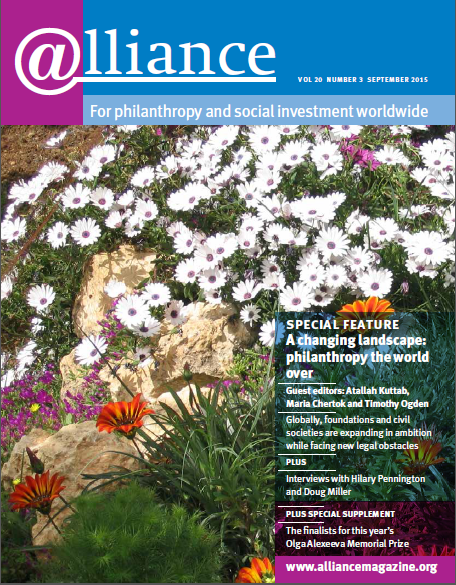Impact investing has captured the imagination of the philanthropy world, where it is often viewed as a panacea for development challenges. Celebrated for its potential, it’s also questioned by business investors and impact seekers. Is it meeting its potential? And if not, what is needed?
As a practitioner of so-called impact investing, I feel it is too early to burden this nascent sector with such high expectations and to examine its credentials in this way.
In simple terms, impact investing is the use of capital and knowledge of investing to seed, support and scale businesses that have the potential to have a sustainable impact on people’s lives. The Global Impact Investing Network (GIIN) defines two critical characteristics of an impact investor: the ‘intent’ of the investor to generate social and/or environmental impact and the ability to report that impact.
The promise of impact investing
The core belief underlying impact investing is that many of the problems faced by people living at the margins – low-income, economically active poor – can be resolved by using a business approach. Impact investors provide capital to support the spawning of businesses.
The enterprises or businesses are expected to be sustainable and create a surplus. Thus the impact will not only be sustainable but potentially grow as well. The argument is that if sustainability, scale of returns, and impact are convincingly developed, it will unlock commercial capital to support impact investing: that has the potential to change the world.
The premise is powerful and potentially disruptive in terms of changing the way the world looks. That is why the field has captured the development world’s imagination over the last decade. Impact investing has also, to some extent, filled the void left by the rapid fall of microfinance from its position as the global solution for poverty reduction.
How to realize the promise?
What would we need to do to realize the potential of impact investing?
The first point to be made is that impact investing is not just about capital. Like venture capital, it is the art and science of building an ecosystem that encourages the best talent and ideas to come together to solve some of the most difficult problems using a business approach.
‘Running an ordinary business is difficult; running an impact enterprise much more so.’
Running an ordinary business is difficult; running an impact enterprise much more so. The business you are building will be serving customers with a small wallet and little ability to pay; they have little risk appetite, meaning they will be slow to adapt to new ideas. You will need to provide the best solution at the lowest price. You can therefore expect a long gestation period, many failures and slow progress towards scale. Hence the need for a great ecosystem – an excellent team and good advisers, along with capital investors who accept a high level of risk, with the patience and maturity to deal with the vagaries of a start-up company.

The Danish Grundfos Foundation, working with a solar‑power service provider, Sunlit Future, is providing the first 28 of 100 solar‑powered powered water pumps to villages in India.
Making the case for investment
Since impact investing is partly about providing capital, the case for investing needs to be made. My view is that what differentiates impact investing from commercial investing is the ‘intent’ of the capital investor. The impact investor:
- focuses on a specific demographic – low-income and poor
- seeks a lower risk-adjusted return – the return an investment will provide in comparison with the level of associated risk
- agrees to be locked in for a longer period
- is willing to balance returns and impact.
It is true that most venture capitalists have a high-risk appetite. The difference is they seek a high risk-adjusted return, while for impact investing, the returns would necessarily be lower on a risk-adjusted basis, if not in absolute terms.
The discussion around the trade-off on returns between commercial capital and impact investing is important and real. I believe that impact investing can deliver absolute returns similar to those of commercial investing, but the risks are greater. Most commercially-early-stage business that has to produce a world-class product for low-income customers carries a high level of risk. On a risk-adjusted basis, such an investment would rarely compete with an IT investment in a highly evolved ecosystem such as Silicon Valley or Bangalore.
The other big challenge is that windfall returns in impact investing, if ever generated, would bring moral hazards – with the sort of consequences that were seen in the microfinance space. The taint of exploiting the vulnerable is never far away. Hence the runaway commercial successes that are possible in mainstream investing are difficult if not impossible in this space.
Nevertheless, a study by Cambridge Associates, a respected firm in venture capital and private equity research, comparing impact investing funds’ performance to those in the private investment space between 1998 and 2014, says:
‘In aggregate, impact investment funds launched between 1998 and 2004 – those that are largely realized – have outperformed funds in a comparative universe of conventional (private investment) funds.’
This is a remarkable achievement given the youth of the sector and the challenges it faces – notwithstanding that a significant percentage of returns would have come from the microfinance sector, which is as commercial as it gets.
JP Morgan in association with GIIN, the Wharton School and EMPEA, are bringing out two new pieces of research piecing together all exits made by impact investors. Unofficial reports suggest that around 67 to 77 exits have been recorded. The three reports together would go a long way in collectively making a case for the commercial potential of impact investing.
What about the impact?
This brings us to the other question: are these investments truly making a difference, and if so, how does one know the outcomes? It is ironic that we started with the belief that our impact thesis was good and we needed to develop our investing thesis. After 15 years, we seem to have gone to the other end of the spectrum, with our investing thesis validated but our impact thesis in tatters.
‘If impact investing is indeed a credible way to bring about development, we must be able to stand up and say how its impact differs from that being generated by commercial investing.’
Most impact funds report their impact by combining the achievements of their enterprises. This is an interesting proxy accepted by most investors. I find it a poor tool simply because all capital invested makes some kind of impact whether it is creating jobs or paying taxes. If impact investing is indeed a credible way to bring about development, we must be able to stand up and say how its impact differs from that being generated by commercial investing.
The more we have tried to justify our impact thesis by looking at outputs such as lives touched, the more hollow our claims about definitive change sound. My take is that impact investors must report their direct contribution:
- the risks they took to seed those enterprises
- how their investment seeded these businesses
- the role the investor played beyond capital in supporting businesses that generated livelihoods, reduced specific vulnerabilities and created those impacts.
The contributions are important to report, but not credible enough, in my view, to justify the existence of an entire sector.
When it comes to reporting developmental outcomes, research needs to be done to find out if impact investors have generated significant ones. Impact investors face a challenging task and are probably not qualified to measure outcomes.
What’s next for impact investing?
Impact investors must fear being cute and nice, and try to make the field significant over the coming years. After 15 years, impact investing funds have not scaled significantly; nor have any of the enterprises funded by it. If we are to realize our ambition to serve the other 3 billion – marginalized people in developing countries – we need to find the way to unlock the capital to scale the funds. Small $2 million investments will not be enough.
The potential of impact investing cannot be realized if we are apologetic about it. We must recognize its disruptive potential and adequately fund investment, and invest in paradigm-shifting innovations that can scale across geographies. After 15 years of seeding and supporting impact enterprises, the time has come for impact investors to provide enough capital to respond meaningfully to the social challenges we face.
We also need to understand that the nature of the impact space demands cooperation and collaboration among its practitioners and open sharing of data. We must encourage honest and transparent debates about our successes and failures in equal measure if we want to find the best possible ways to serve the other 3 billion and help the world to be a better place to live in.
Vineet Rai is founder of the Aavishkaar group of funds, and of Intellecap and its subsidiaries, Intellegrow and Intellecash. Email vineet@aavishkaar.in






Comments (0)